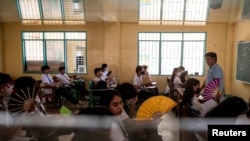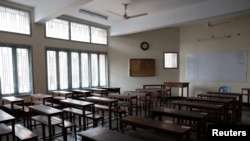Hena Khan, a ninth-grade student in Dhaka, Bangladesh, has struggled to focus on her studies this week as temperatures surpassed 40 degrees Celsius (104 degrees Fahrenheit) in the capital city.
"There is no real education in schools in this punishing heat," she said. "Teachers can't teach, students can't concentrate. Rather, our lives are at risk."
Khan is one of more than 40 million students who have been shut out of classrooms in recent weeks as heat waves have forced school closures in parts of Asia and North Africa.
As the climate warms, heat waves are lasting longer and reaching greater peaks as average temperatures rise. In turn, government authorities and public health experts around the world are grappling with whether to keep students learning in hot classrooms or encourage them to stay home and keep cool.
Either decision has consequences. About 17% of the world's school-aged children are already out of school, according to United Nations data, but the proportion is much larger in developing countries, with nearly a third of sub-Saharan Africa's children out of school compared to just 3% in North America. Children's test scores in the developing world also lag far behind developed countries.
Heat could make that worse, widening learning gaps between tropical developing nations and developed countries, experts told Reuters, and even between rich and poor districts in wealthy countries. But sending children to overheated schools could make them sick.
High temperatures prompt closures
South Sudan shuttered its schools to some 2.2 million students in late March when temperatures soared to 45 degrees Celsius (113 Fahrenheit). Thousands of schools in the Philippines and in India followed suit in late April.
Meanwhile, Bangladesh continues to waver between opening and closing schools for about 33 million students amid pressure to prepare pupils for exams — even as temperatures climb to dangerous levels.
Many of the country's schools "don't have fans, the ventilation is not good, and they might have tin roofing, which does not provide good insulation," said Shumon Sengupta, Bangladesh country director for nonprofit Save the Children.
On Monday, one day after reopening schools that had been closed last week because of the heat, Bangladeshi authorities again closed all primary schools and educational institutions in nearly half of all districts as temperatures reached 43C (109F).
Heat slows cognitive functions
Even if students continue attending classes during heat waves, their education is likely to suffer.
High temperatures slow the brain's cognitive functions, lowering pupils' ability to retain and process information.
U.S. high schoolers, one May 2020 study found, performed worse on standardized tests if they were exposed to higher temperatures in the year leading up to the exam.
The research, published in the American Economic Journal, found that a 0.55C (1F) warmer school year reduced that year's learning by 1%.
Much of that impact disappeared in schools that had air conditioning, said study co-author Josh Goodman, an economist at Boston University.
Somewhere between 40% and 60% of U.S. schools are thought to have at least partial air conditioning, according to various surveys.
Schools that do not are typically found in lower income districts that already lag behind their wealthier counterparts academically. In the U.S. the average performance of the lowest income students is about four years behind the highest-income students, according to a 2019 study in the National Bureau of Economic Research.
Goodman and his colleagues found a similar learning pattern when they looked at standardized test data in other countries.
"When [students in] these places experience a year with more heat, they appear to have learned less," he said.
That is worrying, Goodman added, because as the world warms hot countries moving to an extremely hot climate will suffer more than temperate countries.
"Climate change will widen the learning gaps between hot and cool countries," Goodman said.
The number of days that schools are closed for extreme heat have been ticking up in the U.S., but few countries track such data.
U.S. schools are now canceling class for an average of six to seven school days each year for heat, compared with about three to four days a decade ago, said Paul Chinowsky, a civil engineer who led a 2021 study on schools and rising temperatures for the firm Resilient Analytics, which consults for governments and NGOs.
In Bangladesh, "last year, schools were closed for six to seven days," said Save the Children's Sengupta. "But this year, they are saying it might be closed for three to four weeks."
May is generally the warmest month of the year in South Asia.
More closures worry him, Sengupta said. When children are not in school, they are more vulnerable to child labor and child marriage, according to NGO reports.
Bangladesh Education Minister Mohibul Hasan Chowdhury said on Tuesday that schools would be kept open on weekends if needed to complete the curriculum.
Decisions on school closures, he added, will no longer be a national directive but are to be made at the district level.













